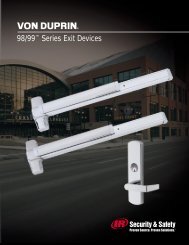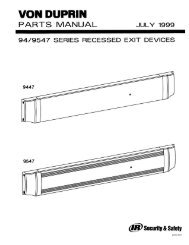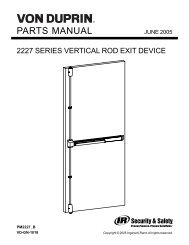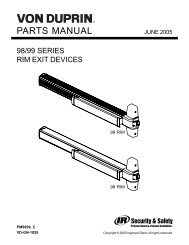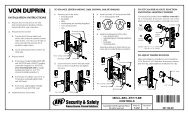Fire, Life Safety & Accessibility Codes - Von Duprin
Fire, Life Safety & Accessibility Codes - Von Duprin
Fire, Life Safety & Accessibility Codes - Von Duprin
You also want an ePaper? Increase the reach of your titles
YUMPU automatically turns print PDFs into web optimized ePapers that Google loves.
1999 Standard Building Code (412.8)<br />
The Standard Building Code contains very similar language to the<br />
BOCA National Building Code, but the High-Rise section of the<br />
SBC refers only to Group B (Business) and Group R (Residential)<br />
high-rise buildings. In addition to being unlocked by a signal from<br />
the fire command center, the doors must also unlock upon actuation<br />
of the sprinkler system or upon power failure. A telephone or other<br />
two-way communication system is required in the stairwell at least<br />
every fifth floor, and must be connected to an approved emergency<br />
service that operates continuously.<br />
1997 Uniform Building Code (403.9)<br />
The Uniform Building Code allows means of egress stairway doors<br />
in certain use groups to be locked as long as they may be unlocked<br />
simultaneously without unlatching upon a signal from the central<br />
control station. The High-Rise section of the Code refers only to<br />
Group B (Business) office buildings and Group R (Residential),<br />
Division 1 occupancies (hotels, apartments, congregate residences).<br />
A telephone or other two-way communication system is required<br />
at least every fifth floor and must be connected to an approved<br />
emergency service that operates continuously.<br />
Stairwell Re-Entry Summary Table<br />
Mechanical Selected<br />
Code Section Locks Re-Entry Electric Locks Two-Way Communication<br />
NFPA 101 7.2.1.5.7 Allowed on Yes, Automatic release actuated Required at every floor of an exit stair<br />
stairs serving 4 Refer to Code by the fire alarm system. in high-rise buildings, connected to the<br />
NFPA 5000 11.2.1.5.2 stories or less central control station (except where<br />
fire department radio system is an<br />
approved equivalent).<br />
IBC 2006 1008.1.8.7 & Not allowed No 4 stories or less - Unlocked Required every fifth floor in stairs where<br />
403.12 by fire command center or doors are locked electrically. Device must<br />
single location at building connect to an approved constantly<br />
entrance. High-rise attended station.<br />
buildings - Unlocked by a<br />
signal from the fire<br />
command center.<br />
IBC 2003 1008.1.8.7 & Allowed on stairs No High-rise buildings, Required every fifth floor in stairs where<br />
403.12 serving 4 stories Unlocked by a signal from doors are locked electrically. Device must<br />
or less the fire command center connect to an approved constantly<br />
(UBC only addresses Use attended station or an approved<br />
BOCA 1014.11.3 & Not specifically No Groups B and R-Div 1). emergency service that operates<br />
403.10 allowed by code. continuously depending on which Code<br />
is used.<br />
UBC 403.9 No<br />
SBC 412.8 No High-rise buildings,<br />
(specific to Use Groups B<br />
& R), unlocked by a signal<br />
from the fire command<br />
center, sprinkler system,<br />
or power failure.<br />
How Do We Accomplish Stairwell Re-Entry?<br />
Several types of hardware may be used for doors that are required to<br />
unlock for stairwell re-entry. Fail-safe electrified locks and fail-safe<br />
electrified fire exit hardware are two options. If the applicable code<br />
allows the use of access-controlled egress doors, an electromagnetic<br />
lock may be used. Since most stairwell doors are fire-rated, a stair<br />
door equipped with an electromagnetic lock must also have a<br />
passage set or passage function fire exit hardware so the door is<br />
self-latching. Another option is a stairwell system consisting of a<br />
modified mortise lock and an electrified frame-mounted operator/<br />
controller. The frame-mounted portion of this system controls the<br />
locking and unlocking of the stair side lever. This system must not be<br />
confused with an electric strike. A fail-safe electric strike may not be<br />
used to accomplish stairwell re-entry because fail-safe electric strikes<br />
are not acceptable for use on fire-rated doors. Several codes mention<br />
that the locks must unlock but remain latched.<br />
The code requirements for stairwell re-entry vary by code publication<br />
so it's extremely important to know which code is being enforced.<br />
While NFPA 101®, NFPA 5000, and the 2003 Edition of the<br />
International Building Code® allow some stair doors to be<br />
mechanically locked, other codes may not. If you specify or supply<br />
877.840.3621 • www.securitytechnologies.ingersollrand.com<br />
hardware that is in compliance with one code, you may be in<br />
violation of another. I have witnessed this first-hand when a local<br />
fire marshal asked me to help him find a way to deny the use of<br />
mechanical locks on stair doors in a four-story retail store. The fire<br />
marshal was enforcing NFPA 101®, which allowed the doors to be<br />
mechanically locked. I advised him that the State Building Code did<br />
not allow the stair doors to be locked. The fire marshal contacted<br />
the building inspector, who enforced the building code, and the<br />
locks were removed.<br />
The following codes were researched for this article. For more<br />
information, determine the code that is being enforced and refer to<br />
the appropriate edition of that code. As always, the code official<br />
makes the final decision.<br />
• International Building Code® (IBC) – 2003, 2006<br />
• BOCA National Building Code (BOCA) - 1999<br />
• NFPA 101® <strong>Life</strong> <strong>Safety</strong> Code® (NFPA 101®) – 2003, 2006<br />
• Standard Building Code (SBC) - 1999<br />
• NFPA 5000 Building Construction & <strong>Safety</strong> Code (NFPA 5000)<br />
– 2003, 2006<br />
• Uniform Building Code (UBC) – 1997<br />
31





